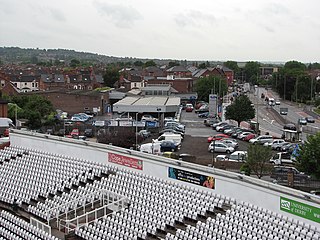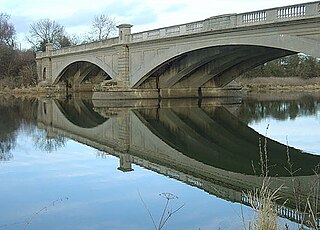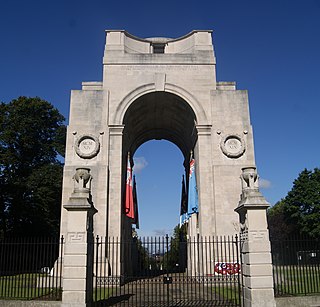
Nottinghamshire is a ceremonial county in the East Midlands of England. The county borders South Yorkshire to the north-west, Lincolnshire to the east, Leicestershire to the south, and Derbyshire to the west. The largest settlement is the city of Nottingham (323,632).

Rushcliffe is a local government district with borough status in Nottinghamshire, England. Its council is based in West Bridgford. The borough also includes the towns of Bingham and Cotgrave as well as numerous villages and surrounding rural areas. Some of the built-up areas in the north-west of the borough, including West Bridgford, form part of the Nottingham Urban Area.

West Bridgford is a town and the administrative centre of the Borough of Rushcliffe in the county of Nottinghamshire, England. It lies immediately south of Nottingham, east of Wilford, north of Ruddington and west of Radcliffe-on-Trent. It is southwest of Colwick and southeast of Beeston which are on the opposite bank of the River Trent. The town is part of the Nottingham Urban Area and had a population of 48,225 in a 2018-estimate.

East Bridgford is a village and civil parish in the Rushcliffe borough of Nottinghamshire, east of the city of Nottingham. It had a population of 1,814 at the 2011 census. The village adjoins the south bank of the River Trent, opposite the village of Gunthorpe. It is on the Trent Valley Way. East Bridgford's an annual village show is run by the village Horticultural Society, established in 1864, and held every Feast Week.

Lady Bay Bridge is a road bridge of two lanes that spans the River Trent in West Bridgford, Nottingham. It is the bridge following (downstream) from Trent Bridge and connects the main thoroughfare of Radcliffe Road with Meadow Lane.

Nottingham Council House is the city hall of Nottingham, England. The 200 feet (61 m) high dome that rises above the city is the centrepiece of the skyline and presides over the Old Market Square which is also referred to as the "City Centre". It is a Grade II* listed building.

Trent Bridge is an iron and stone road bridge across the River Trent in Nottingham, England. It is the principal river crossing for entrance to the city from the south, although the upstream Clifton Bridge is both larger and busier.

Hanbury is a rural village and civil parish 3.3 miles (5.3 km) west-north-west of Burton-on-Trent in Staffordshire, England. It is bounded to the north by the River Dove.

Gunthorpe Bridge is a bridge over the River Trent at Gunthorpe, Nottinghamshire.

The Meadows or Meadows is an area of Nottingham, England, south of the city centre, close to the River Trent and connected to West Bridgford in the Borough of Rushcliffe by Trent Bridge and the Wilford Suspension Bridge. Victoria Embankment runs alongside the River Trent to the south of the Meadows and is home to the Nottingham War Memorial Gardens.

The Henry P. Davison House is a mansion located at 690 Park Avenue and 69th Street on the Upper East Side of Manhattan, New York City.

The London Troops War Memorial, located in front of the Royal Exchange in the City of London, commemorates the men of London who fought in World War I and World War II.

The Arch of Remembrance is a First World War memorial designed by Sir Edwin Lutyens and located in Victoria Park, Leicester, in the East Midlands of England. Leicester's industry contributed significantly to the British war effort. A temporary war memorial was erected in 1917, and a committee was formed in 1919 to propose a permanent memorial. The committee resolved to appoint Lutyens as architect and to site the memorial in Victoria Park. Lutyens's first proposal was accepted by the committee but was scaled back and eventually cancelled due to a shortage of funds. The committee then asked Lutyens to design a memorial arch, which he presented to a public meeting in 1923.

A statue of Captain Albert Ball stands in Nottingham Castle Gardens, in Nottingham, England. It comprises a bronze sculpture by Henry Poole which depicts the British fighter pilot Captain Albert Ball VC DSO & Two Bars, MC accompanied by an allegorical female figure, standing on a stone pedestal by the architect Edwin Alfred Rickards. The memorial was unveiled in 1921, was listed at Grade II in 1972, upgraded to Grade I in 2017.

Nottinghamshire County Hall is a large municipal building located at Loughborough Road on the south bank of the River Trent at West Bridgford in Rushcliffe, Nottinghamshire, England. It is the headquarters of Nottinghamshire County Council which is the upper tier local authority and has jurisdiction across the whole of Nottinghamshire except the City of Nottingham which is administered independently by the unitary authority of Nottingham City Council.

The City of Portsmouth War Memorial, also referred to as the Guildhall Square War Memorial, is a First World War memorial in Guildhall Square in the centre of Portsmouth, Hampshire, on the south coast of England. Portsmouth was and remains a port and home to a major naval dockyard. The dockyard and the armed forces provided much of the employment in the area in the early 20th century. As such, the town suffered significant losses in the First World War. Planning for a war memorial began shortly after the end of the conflict and a committee was established for the purpose. It selected a site adjacent to a railway embankment close to the Town Hall and chose the architects James Gibson and Walter Gordon, with sculptural elements by Charles Sargeant Jagger, from an open competition.
The Waterside Bridge is a planned pedestrian and cycle bridge over the River Trent in Nottingham, England. When built, it will be the first new river bridge in Nottingham since the Clifton Bridge was built sixty years ago.























